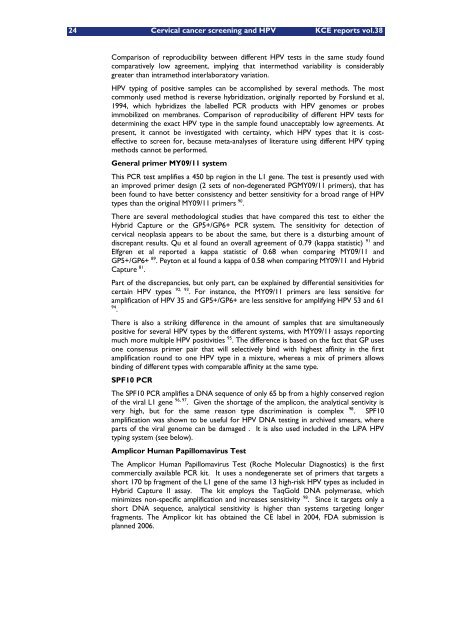Cervical Cancer Screening and Human Papillomavirus (HPV ... - KCE
Cervical Cancer Screening and Human Papillomavirus (HPV ... - KCE
Cervical Cancer Screening and Human Papillomavirus (HPV ... - KCE
Create successful ePaper yourself
Turn your PDF publications into a flip-book with our unique Google optimized e-Paper software.
24 <strong>Cervical</strong> cancer screening <strong>and</strong> <strong>HPV</strong> <strong>KCE</strong> reports vol.38<br />
Comparison of reproducibility between different <strong>HPV</strong> tests in the same study found<br />
comparatively low agreement, implying that intermethod variability is considerably<br />
greater than intramethod interlaboratory variation.<br />
<strong>HPV</strong> typing of positive samples can be accomplished by several methods. The most<br />
commonly used method is reverse hybridization, originally reported by Forslund et al,<br />
1994, which hybridizes the labelled PCR products with <strong>HPV</strong> genomes or probes<br />
immobilized on membranes. Comparison of reproducibility of different <strong>HPV</strong> tests for<br />
determining the exact <strong>HPV</strong> type in the sample found unacceptably low agreements. At<br />
present, it cannot be investigated with certainty, which <strong>HPV</strong> types that it is costeffective<br />
to screen for, because meta-analyses of literature using different <strong>HPV</strong> typing<br />
methods cannot be performed.<br />
General primer MY09/11 system<br />
This PCR test amplifies a 450 bp region in the L1 gene. The test is presently used with<br />
an improved primer design (2 sets of non-degenerated PGMY09/11 primers), that has<br />
been found to have better consistency <strong>and</strong> better sensitivity for a broad range of <strong>HPV</strong><br />
types than the original MY09/11 primers 90 .<br />
There are several methodological studies that have compared this test to either the<br />
Hybrid Capture or the GP5+/GP6+ PCR system. The sensitivity for detection of<br />
cervical neoplasia appears to be about the same, but there is a disturbing amount of<br />
discrepant results. Qu et al found an overall agreement of 0.79 (kappa statistic) 91 <strong>and</strong><br />
Elfgren et al reported a kappa statistic of 0.68 when comparing MY09/11 <strong>and</strong><br />
GP5+/GP6+ 89 . Peyton et al found a kappa of 0.58 when comparing MY09/11 <strong>and</strong> Hybrid<br />
Capture 81 .<br />
Part of the discrepancies, but only part, can be explained by differential sensitivities for<br />
certain <strong>HPV</strong> types 92, 93 . For instance, the MY09/11 primers are less sensitive for<br />
amplification of <strong>HPV</strong> 35 <strong>and</strong> GP5+/GP6+ are less sensitive for amplifying <strong>HPV</strong> 53 <strong>and</strong> 61<br />
94 .<br />
There is also a striking difference in the amount of samples that are simultaneously<br />
positive for several <strong>HPV</strong> types by the different systems, with MY09/11 assays reporting<br />
much more multiple <strong>HPV</strong> positivities 95 . The difference is based on the fact that GP uses<br />
one consensus primer pair that will selectively bind with highest affinity in the first<br />
amplification round to one <strong>HPV</strong> type in a mixture, whereas a mix of primers allows<br />
binding of different types with comparable affinity at the same type.<br />
SPF10 PCR<br />
The SPF10 PCR amplifies a DNA sequence of only 65 bp from a highly conserved region<br />
of the viral L1 gene 96, 97 . Given the shortage of the amplicon, the analytical sentivity is<br />
very high, but for the same reason type discrimination is complex 98 . SPF10<br />
amplification was shown to be useful for <strong>HPV</strong> DNA testing in archived smears, where<br />
parts of the viral genome can be damaged . It is also used included in the LiPA <strong>HPV</strong><br />
typing system (see below).<br />
Amplicor <strong>Human</strong> <strong>Papillomavirus</strong> Test<br />
The Amplicor <strong>Human</strong> <strong>Papillomavirus</strong> Test (Roche Molecular Diagnostics) is the first<br />
commercially available PCR kit. It uses a nondegenerate set of primers that targets a<br />
short 170 bp fragment of the L1 gene of the same 13 high-risk <strong>HPV</strong> types as included in<br />
Hybrid Capture II assay. The kit employs the TaqGold DNA polymerase, which<br />
minimizes non-specific amplification <strong>and</strong> increases sensitivity 98 . Since it targets only a<br />
short DNA sequence, analytical sensitivity is higher than systems targeting longer<br />
fragments. The Amplicor kit has obtained the CE label in 2004, FDA submission is<br />
planned 2006.

















